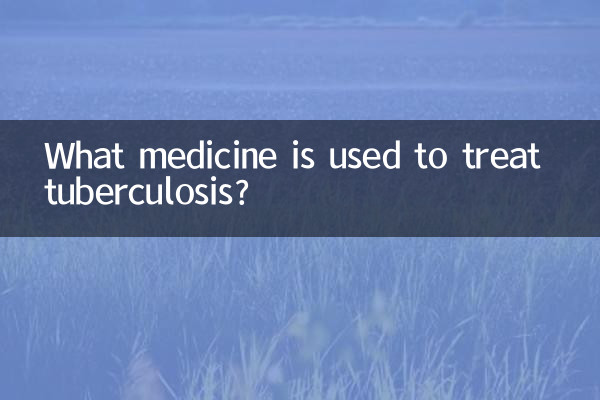What medicine is used to treat tuberculosis?
Tuberculosis (TB) is a chronic infectious disease caused by Mycobacterium tuberculosis, which mainly invades the lungs but may also affect other organs. In recent years, the treatment options and drug selection for tuberculosis have been continuously updated. This article will combine the hot topics and hot content on the Internet in the past 10 days to give you a detailed introduction to the drug selection and precautions for treating tuberculosis.
1. Commonly used drugs for the treatment of tuberculosis

Treatment of pulmonary tuberculosis usually requires the combined use of multiple anti-tuberculosis drugs to reduce the development of drug resistance. The following are the anti-tuberculosis drugs currently commonly used clinically:
| Drug name | Mechanism of action | Common side effects |
|---|---|---|
| Isoniazid | Inhibit tuberculosis cell wall synthesis | Hepatotoxicity, peripheral neuritis |
| Rifampicin | Inhibit RNA polymerase | Hepatotoxicity, gastrointestinal reactions |
| Pyrazinamide | Interference with tuberculosis metabolism | Hepatotoxicity, joint pain |
| Ethambutol | Inhibit tuberculosis RNA synthesis | Optic neuritis |
| Streptomycin | inhibit protein synthesis | Ototoxicity, nephrotoxicity |
2. Standard treatment plan for tuberculosis
According to the recommendations of the World Health Organization (WHO), the standard treatment plan for tuberculosis is divided into two phases: the intensive phase and the consolidation phase. The following are specific treatment options:
| treatment stage | drug combination | Course of treatment |
|---|---|---|
| Reinforcement period | Isoniazid, rifampicin, pyrazinamide, ethambutol | 2 months |
| Consolidation period | Isoniazid, rifampicin | 4 months |
3. Treatment of drug-resistant pulmonary tuberculosis
In recent years, drug-resistant tuberculosis (especially multidrug-resistant tuberculosis, MDR-TB) has become the focus of global attention. Treatment of drug-resistant pulmonary tuberculosis requires drug selection based on drug susceptibility test results, with longer treatment courses and greater drug side effects. The following are commonly used drugs for drug-resistant tuberculosis:
| drug class | Representative medicine | Applicable situations |
|---|---|---|
| Fluoroquinolones | Moxifloxacin, levofloxacin | multidrug-resistant tuberculosis |
| Second-line injectable drugs | Amikacin, kanamycin | multidrug-resistant tuberculosis |
| New anti-tuberculosis drugs | bedaquiline, delamanid | extensively drug-resistant tuberculosis |
4. Precautions for treating tuberculosis
1.Take medication strictly as prescribed by your doctor: The treatment of pulmonary tuberculosis requires long-term persistence, and the drug cannot be stopped or reduced at will, otherwise it may lead to treatment failure or the development of drug resistance.
2.Regular review: During the treatment period, liver function, kidney function and other tests, as well as sputum smear and culture, need to be carried out regularly to evaluate the treatment effect.
3.Be aware of drug side effects: Anti-tuberculosis drugs may cause side effects such as liver damage and gastrointestinal reactions. If you feel unwell, you should seek medical treatment in time.
4.nutritional support: Tuberculosis patients need to ensure adequate nutritional intake, especially protein and vitamins, to enhance immunity.
5. Hot topics about tuberculosis on the Internet in the past 10 days
1.Progress in the development of new anti-tuberculosis drugs: Recently, the clinical application of new drugs such as bedaquiline and delamanid has become a hot topic, bringing hope to patients with drug-resistant tuberculosis.
2.Tuberculosis vaccine research: Multiple teams around the world are developing new tuberculosis vaccines to replace the current Bacillus Calmette-Guerin (BCG) vaccine, which has limited effectiveness.
3.Collaborative prevention and control of tuberculosis and COVID-19: Under the new coronavirus epidemic, the diagnosis and treatment of tuberculosis have been affected to a certain extent, and how to balance the prevention and control of the two infectious diseases has become the focus of discussion.
4.Application of artificial intelligence in tuberculosis diagnosis: AI technology assists chest imaging diagnosis and drug sensitivity testing, improving the early detection rate and treatment accuracy of tuberculosis.
Conclusion
The treatment of pulmonary tuberculosis is a long-term and complex process. Patients need to take medication regularly under the guidance of a doctor, while also paying attention to lifestyle adjustments and regular review. With the advancement of medical technology, the development of new anti-tuberculosis drugs and vaccines has brought a new dawn to the prevention and control of tuberculosis. If you or someone around you is suspected of having tuberculosis, please seek medical treatment promptly. Early diagnosis and treatment are key.

check the details

check the details